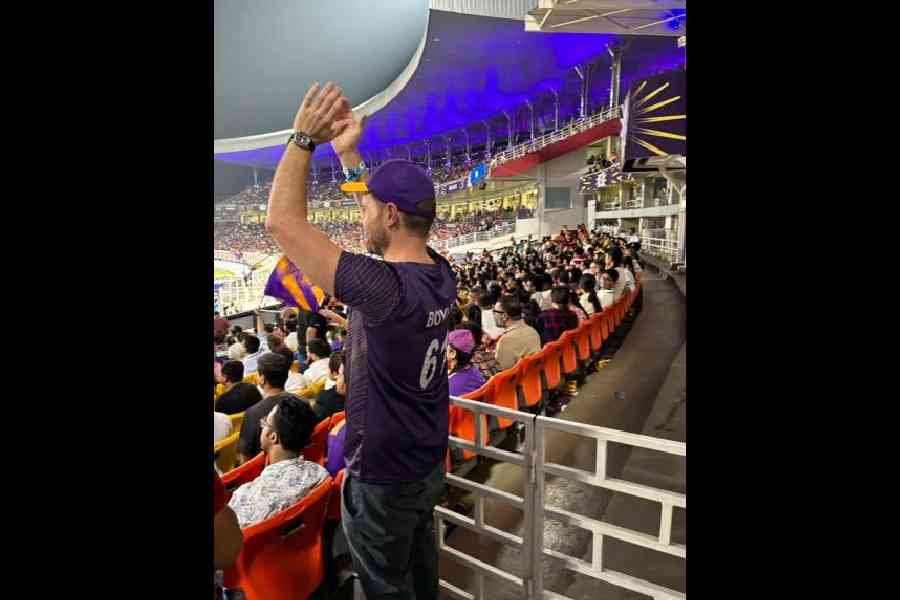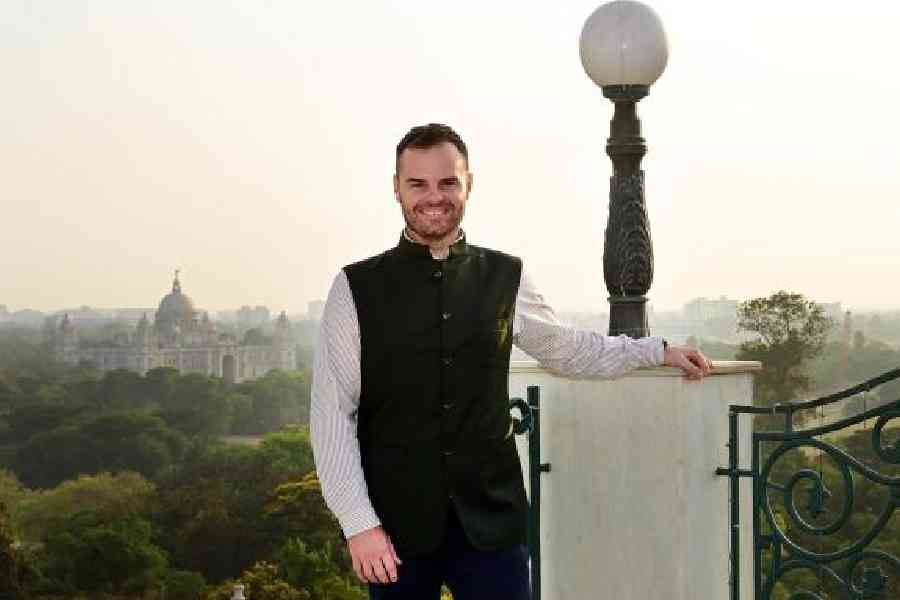It’s been close to three months that Hugh Boylan has checked into the Australian consulate general office. A t2 chat with the consul general who even has his own Kolkata Knight Riders (KKR) jersey.
You have been here for some time now. Which is your favourite place to visit in Calcutta?
I’ve been to Calcutta a few times as a tourist and it may sound odd that I find the Park Street cemetery to be one of the most peaceful places to visit. Some of those old graves and the history are quite incredible.
There’s a Satyajit Ray detective story set in that cemetery.
Really? I was looking for modern cultural spins that are coming out of Calcutta and a friend recommended a (web) series called Tooth Pari. It’s always interesting to see the city that you live in being portrayed on screen. That show, about vampires living in Calcutta, definitely gave me a different spin of the city. (laughs) I happily noticed that Tilottama Shome was in it. Having met her at (The Telegraph) She Awards, I felt like that was my brush with fame.
You held Anzac Day at another cemetery.
We had a fantastic Anzac day dawn service at the Bhowanipore cemetery. We had a turnout from Australians, including some who’ve been living here for long, and the New Zealand honorary consul. Four Australians are laid to rest there and two New Zealanders — all from the Air Force Signal Corps. The oldest was 28 and the youngest 23. The Australian and New Zealand Army Corps (Anzac) side of the story is well-known. But there were a lot of Indians that served at the Gallipoli as well. I found an anecdote that when they arrived at Gallipoli, transportation on motorised vehicles proved to be impractical and Indian mules came to the rescue. India, like Australia and New Zealand, suffered heavy casualties in the war. The occasion allowed us to reflect on that. Then we had what’s called a gunfire breakfast.
That’s an interesting name.
It’s called so not because there’s a gun salute, but because the soldiers used to have a bit of rum in their black tea before going to battle. That drink was known as gunfire.
Incidentally, the Election Commission of India used mules to carry Electronic Voting Machines to some remote polling booths.
I did read somewhere that India has the highest polling station in the world (Tashigang in Himachal Pradesh). In fact, I was in Darjeeling a few weeks ago. It was cool there, really nice.
You mentioned having been to Darjeeling before. Did you notice any changes?
I was there as a backpacker when I was 24. That was around 2009. I remember it being incredibly beautiful. The biggest change was how I got there. The first time I was on a minibus.
Not a mule?
No (laughs), a minibus, which, unfortunately, broke down. It was quite cold and my friends, two fellow-Australians and I, ended up on the roof of another minibus to make it to Darjeeling. This time I was in a car. I took a tour of the Glenburn tea estate. It’s got a real sense of history.
Was it colder back then?
Yes, as it was December. Still, it was bustling as it is now. I had come to India earlier, with my school, when I was 16. India was the first country that I visited in the world.
I grew up in Adelaide. In 2001, it was a beautiful city that had the feel of a large country town with wide streets and not much traffic. I remember landing in Chennai, where our trip began, and taking an auto rickshaw. I was looking out at the size of the city with the widest eyes. The largest place I’d been till then was Sydney which I think at that time had a population of about five million. So the size of the city and the traffic and the crowd — that perhaps was the start of my love of India. That’s why I came back as a tourist and then to work in Delhi and now here as consul general.

Australian consul general Hugh Boylan cheers for KKR at Eden Gardens in his own jersey
Which places were covered on your school trip?
I was in Calcutta for about five days. We did Chennai, Agra, Varanasi, Delhi, Calcutta and Hazaribag in Bihar.
That sounds like so much fun. Which school was that?
St Ignatius College. There were nine of us.
The school is called college?
Yes, that’s a thing in Australia. Some schools just have that name. I suppose it’s in the same sense that we say university and Americans say college for that part of our education. In my school, you finish at the age of 17-18 years and move on to university. That trip to India would take place every two years. They might still be doing it. If they come while I’m here, I’ll show them around.
Did your school specifically have India as the tour destination?
I think there was also Europe on offer but the opportunity to go to India captured my imagination. It was summer for Australia, in 2001-02.
So you came here for the first time at 16, then again at 24 as a backpacker.
Yes. Then I moved to Delhi in March 2021 as an economic counsellor at the Australian High Commission. I finished that job last year, went home for a few months and then started in Calcutta in March.
So is this your first posting as consul general?
Yes. I’m most excited about opportunities for trade and business because in Delhi that was a big focus of my work — increasing two-way trade investment. That included the India Economic Strategy update as well as our free trade agreement. This is the first time when I’ve been living in a country when one of our free trade agreements has entered into force.
The other day, I was with some colleagues from Austrade and they had a chef teaching Indian chefs how to cook Australian lamb. I was eating the lamb when I thought that I’m seeing the free trade agreement move from paper to plate.
That is one of the reasons why I’m excited to be able to stay in India so I can keep seeing that impact. There’s so much more of what we can do to raise awareness about opportunities.
The TV show, Masterchef Australia, is very popular here.
We had the runner-up in Masterchef Australia (in 2011), a very close friend of mine, Michael Weldon, who was also on the Fans & Favourites show of 2022. He has a TV show now, called Farm to Fork. He went around promoting Australia’s food and beverage options. He came to Calcutta and did a street food cook-off. We were having lunch in Bengaluru and a woman came up and said: “Excuse me, are you Michael from Masterchef?” I didn’t realise that Masterchef Australia had a big following in India!
Gary Mehigan (a Masterchef Australia judge) came to cover Durga puja year before last for National Geographic.
He was here again more recently, I think. Australians eat a lot of food from different Asian countries, including Indian food. I did a streetfood tour here recently. I had Fried Fish with yellow mustard, which was delicious. My favourite Indian food is Kathi Roll with chicken and egg. I’ve been to Nizam’s more times than I care to admit... (laughs) and to Kusum. That was in my introduction-to-Calcutta video on Twitter. We also went to College Street for the bookstores.
Where else have you been to?
Shilllong and Nagaland. Everywhere I go, I try to get people excited about visiting Australia, which in India is not so difficult. Indian visitors to Australia were among the first to bounce back after the pandemic. In fact, arrivals of Indians to Australia have reached a new record, with more than 410,000 visiting in the past year. A lot of that were students and the diaspora, which is getting close to a million which, for a country of Australia’s size, is significant. Punjabi is the fastest-growing language spoken at home in Australia.
You pitched Australia even in the video you posted from Darjeeling.
Well, when you’re in a place as beautiful as Darjeeling you are inspired to talk about the importance of visiting beautiful places. (laughs) The number of Australians visiting India is also increasing.
A prominent Australian player is in the Calcutta cricket team.
Mitchell Starc. Very proud of my new home team KKR winning the IPL! I am also proud of my KKR jersey for which I chose number 61 as +61 is Australia’s international calling code. I went to see KKR in action against Delhi Capitals. The energy in Eden Gardens is electric. Cricket binds India and Australia together in healthy rivalries. Rowan (Ainsworth, his predecessor) did a lot of sports diplomacy in programmes with children and I’m looking forward to doing that as well.
